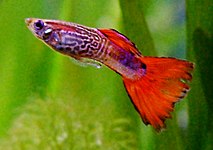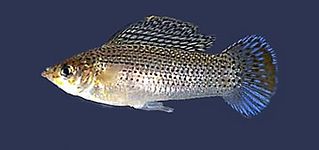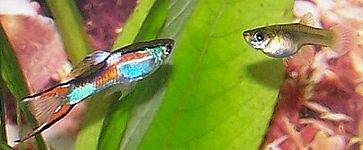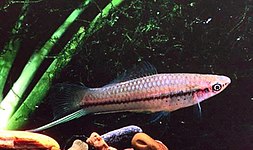This is an old revision of this page, as edited by Softking66 (talk | contribs) at 09:00, 4 October 2015 (Little more info added). The present address (URL) is a permanent link to this revision, which may differ significantly from the current revision.
Revision as of 09:00, 4 October 2015 by Softking66 (talk | contribs) (Little more info added)(diff) ← Previous revision | Latest revision (diff) | Newer revision → (diff)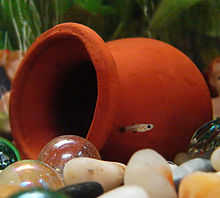
Live-bearing aquarium fish, often simply called livebearers, are fish that retain the eggs inside the body and give birth to live, free-swimming young.
Common aquarium livebearers
Species of interest to aquarists are almost always members of the family Poeciliidae, most commonly guppies, mollies, platies, swordtails, Endler's livebearer, and mosquito fish.
Live-bearing aquarium fish, often simply called livebearers, are fish that retain the eggs inside the body and give birth to live, free-swimming young. Because the newborn fish are large compared to the fry of oviparous fish, they are easier to feed than the fry of egg-laying species such as characins and cichlids. This makes them much easier to raise, and for this reason, aquarists often recommend them for beginners to fish breeding. In addition, being much larger makes them far less vulnerable to predation, and with sufficient cover, they can sometimes mature in a community tank.
Ovoviviparous and viviparous fish compared
Most of the Poeciliidae are ovoviviparous, that is, while the eggs are retained inside the body of the female for protection, the eggs are essentially independent of the mother and she does not provide them with any nutrients. In contrast, fish such as splitfins and halfbeaks are viviparous, with the eggs receiving food from the maternal blood supply through structures analogous to the placenta of placental mammals.
Aberrant livebearers and mouthbrooders
Seahorses and pipefish can be defined as livebearers, although in these cases the males incubate the eggs rather than the females. In many cases, the eggs are dependent on the male for oxygen and nutrition, so these fish can be further defined as viviparous livebearers.
Many cichlids are mouthbrooders, with the female (or more rarely the male) incubating the eggs in the buccal cavity. Compared with other cichlids, these species produce fewer but bigger eggs, and when they emerge, the fry are better developed and have a higher survivability. Because the eggs are protected from the environment but do not absorb nutrients from the parent, this condition is analogous to, though not identical with, ovoviviparity.
Considerations
The four major considerations for getting your tropical live-bearers to breed are water quality, heat, light, and diet. If these factors are kept in the optimal range for your species of fish, they will be far more likely to reproduce in your aquarium. Another consideration is that live-bearers will sometimes eat their young. Keeping large amounts of vegetation in your aquarium can help give the fry places to hide in order to avoid cannibalism. Also, it is important to keep your brood stock well feed, preferably on both an algal and live diet. These fish, if given the proper conditions, can have hundreds of live young per brood and can give birth multiple times a year. Due to their high fecundity, it’s important to have enough space for the newly hatched fry. If the population in your tank gets too large, it might be necessary to move the breeding pairs into separate tanks, although the females can continue to carry fertilized eggs after the males have been removed.
Livebearer fish gallery
External links
- American Livebearer Association
- British Livebearer Association
- Keeping & Breeding Halfbeaks Includes growth rate chart and pictures of newborn fish.
- How to Keep & Breed Livebearers
- Aquarium Network
